
Portable Surgical Kits Page Menu: 1 2 3 4 5 6 7 8 9 Next>>
Portable Surgical Kits From the Golden Age of Piracy, Page 2
Plaster Box and Pocket Kit Instruments - Plaster Box Only
1. Director
Included by: Thomas Brugis & Randle Holme
Only a third of the authors who list the contents of the plaster box mention a surgical director, which is curious given how small and potentially helpful it would have been.
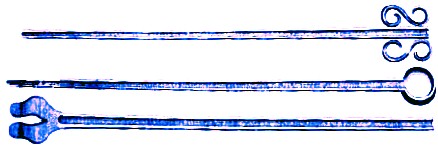
Surgical Directors, From A General System of Surgery, By Lorenz Heister (1750)
Thomas Brugis gives a simple, direct explanation for the use of this surgical tool: "The Director is an Instrument to guide and direct the Incision Knife, in Dilation, or enlarging a Wound, when you are near any Vessels."1 Lorenz Heister expands upon this, noting that the director is grooved to guide "the Edge of the Knife or Scissors in opening Sinuses or Fistulæ"2. He notes that that the ornamental ends can be used for a variety of different purposes, the simplest being to provide a way to hold the instrument (top), or to serve as a spoon "to contain a Powder to sprinkle upon Wounds or Ulcers" (middle) or even for specific surgeries, such as the forked director used "to divide the Frænum [the fold underneath] of the Tongue"3.
1 Thomas Brugis, Vade Mecum, 1689, p. 6; 2,3 Lorenz Heister, A General System of Surgery in Three Parts, 1750, p. 12
2. Elevator
Included by: John Woodall, James Cooke & Randle Holme
Three of the six authors who discuss plaster box instruments include an elevator. It was often made entirely of iron with both ends often featuring different types of elevators, although some examples exist with a single end and a wooden handle. For portable kits, a two-ended instrument would be more practical because it was save space and provide more versatility.
Elevators are often referred to in period texts as 'Levatories'. They were often used to prize up the bones of the skull during head surgery.
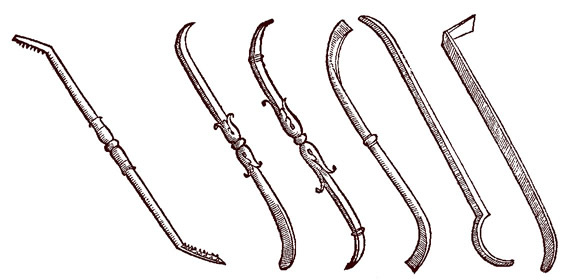
Various Styles of Elevators, Chirurgiae Universalis Opus
Absolutum, Giovanni Andrea della Croce (1596)
James Cooke says that the tool was "to raise up depressed bones in fractures of the scul, especially if they do or may cause ill symptomes, otherwise nature will discharge that office."1 The fractured bone of the skull pressing against the brain caused all sorts of problems for the patient.
Sea surgeon John Woodall concurs, noting that a "Levatory [elevator] is a necessary instrument to elevate the depressed Cranium... and a fit instrument in the Surgeons chest."2 This is a surprisingly task-specific instrument for inclusion in the first aid box, given the large array of instruments normally recommended for performing surgery on the head. However, not all head wounds were so catastrophic that they required such a large array of instruments and the elevator may have been the most versatile instrument of them.
1 James Cooke, Supplementum chirurgiae and the Military Chest, 1655, p. 423; 2 John Woodall, the surgions mate, 1617, p. 7
3. Speculum Oculi
Included by: James Cooke, Thomas Brugis & Randle Holme
Half of the six authors who list the contents of plaster boxes include this instrument, suggesting reasonably strong support for its addition to the tool set. Being fairly small and thin, it would not have taken up much room in the little box.

Speculum Oculi and Its Use, From A General
System of
Surgery, Lorenz Heister (1750)
The speculum oculi is used to hold the eye open when treating eye wounds and related problems. Randle Holme describes it as "an Instrument like a Ring fixed on the end of a pin, or strong silver wyer [wire]". He also notes that "Some Chyrurgions have the Ring open above"1 Drawing upon the works of French surgeon Ambroise Paré, surgeon Helkiah Crooke says that the tool is made "according to the bignesse or smallnesse of the eye, or as you would have it extended or drawne in, it may be made wider or
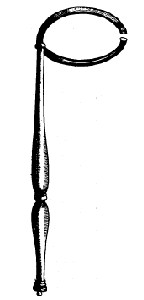
Open Ring Speculum Oculi,
From The French
Chirurgerye,
By Jacques
Guillemeau, p. 25 (1612)
narrower, at your pleasure"2, probably referring to a tool with an open ring that can be manually bent to be more open or closed.
Holme notes that the speculum oculi can be used when a "Haw [infection], or Cataract, or the like, is cutting of[f] the sight of the eye; and also for other operations to be performed on the same."3 Crooke explains the instrument is used when "small motes fall into the Eye which are sometimes hard to get out"4.
It is unlikely that a ship's surgeon would perform an intricate operation such as the removal of a cataract, so Crooke's explanation is probably the more likely reason a speculum oculi would be used at sea. Holme's description of its use is quite simple, advising that the surgeon should "put it over the Ball of the eye to keep both the eye and the lids stiddy, and firm from motion"5. Crooke's explanation is more intricate. "You must insinuate it under the eye-lids, next to the white of the eye, and so separate the lids as farre asunder as you can without too much violence and withal, hold the eye steady"6.
1 Randle Holme, The academy of armory, Book III, 1688, p. 430; 2 Helkiah Crooke, An Explanation of the Fashion and Use of Three and fifty Instruments of Chirurgery, 1634, p. 28; 3 Holmes, p. 430; 4 Crooke, p. 28; 5 Holme, p. 430; 6 Crooke, p. 28
Plaster Box and Pocket Kit Instruments - Plaster Box & Pocket Kit
4. Burras Pipe
Included by: Charles Gabriel Le Clerc, William Fabry, John Woodall, James Cooke & Randle Holme
Burras pipes enjoyed wide support among those who discussed portable instrument kits, being found in the descriptions of five of the eight authors under study. This is not surprising, based on its function.
Very little is mentioned by period surgeons to describe the 
A Stitching Quill. Which Could Double as a Burras Pipe, From Mellificium chiurgiae, By James Cooke, p. 117 (1685)burras pipe. German surgeon William Fabry gives a deceptively simple explanation for the use of the device: "A Burrus quill, to sprinkle Powders upon Wounds or Ulcers."1 What he doesn't discuss is the nature of such powders.
A burras pipe was usually used to hold corrosives or 'potential cauteries'. Surgeon James Cooke says, "“The burras pipe is to preserve in it corroding powder, as præcipitate [of mercury], turbith mineralis, burnt alum, &c."2 Sea surgeon John Woodall similarly suggests the burras pipe is "for the most part to reteyne corroding powders in, as Vitrioll, burnt Allom, præcipitate, and such other causticke medicines, which well used performe very much in healing"3. French surgeon Charles Gabriel Le Clerc simply refers to the contents as a "cauterizing Button"4, perhaps referring to the round, bulbous shape of the cauterizing powder the pipe left behind. These potential cautery powders were used to burn the skin for various reasons.
Cooke explains they were "cast on proud [unwanted and overgrown] flesh, appearing in wounds and ulcers."5 Potential cauteries could also be used to create a fontanel - a wound in the skin which was intentionally kept open to allow the passage of unwanted fluids from the body. It is likely that Le Clerc had this in mind when he explained that the pipe was used "to convey the cauterizing Button to a remote Part, without running the hazard of burning those that are near it."6 Sea surgeon John Woodall even recommended their use in opening apostemes or swollen abscesses.7

Photo: Peter J. Goebel - Burras Box Reproduction, Goose Bay Workshops LLC
The idea of a burras pipe is derived from the burras box which was a metal box with a spout used to hold flux for use by gold- and silver-smiths. The burras pipe appears to have been derived from this box, which Randle Holme explains is removed "by little and little out of the Knobbed Pipe"8.
No obvious images of a burras pipe appear from the period. This is likely because it was basically a small pipe with one end sealed closed and the other having a removable cap. This is apparent from James Cooke's explanation that the burras pipe and stitching quill (or cannula) "may [all] be included in one [instrument]"9. As a result, the image of a stitching quill must serve as proxy for the burras pipe/quill unless some other image is found.
1 Guliielm. Fabritius Hildanus aka. William Fabry. Cista Militaris, Or, A Military Chest, Furnished Either for Sea or Land, 1676, p. 23; 2 James Cooke, Supplementum chirurgiae and the Military Chest, 1655, p. 420; 3 John Woodall, the surgions mate, 1617, p. 31; 4 Charles Gabriel Le Clerc, The Compleat Surgeon, 1701, p. 5; 5 Cooke, p. 421; 6 Le Clerc, p. 5; 7 Woodall, p. 1; 8 Randle Holme, The academy of armory, Book III, 1688, p. 308; 9 Cooke, p. 420
5. Crooked Knife
Included by: Charles Gabriel Le Clerc
Only one author specifically recommends that a crooked knife be included in the portable kit. This may have been because the surgeon could make do with a straight incision knife and save the space such an instrument would occupy in a portable kit.
The crooked knife is what we would call a curved scalpel. French surgical instructor Pierre Dionis says that this blade can be referred to as "a curve, crooked or bent Incision Knife"1.

Ornate Folding Crooked Incision Knife, From An Explanation of the Fashion and Use
of Three
and fifty
Instruments of Chirurgery, By Helkiah Crooke, p. 4 (1634)
Randle Holme named it a crooked pen-knife.2 Most surgeons seem to have called it crooked knife, however. Dionis explained that the crooked knife "is shap’d like a Crescent, its [sharp] Edge innermost, and [not sharp] Back on the Outside"3. German surgeon Johannes Scultetus said that "it cuts on the hollow side, and is blunt on the convex side of it."4 This is usual for curved surgical blades, such as the amputation knife. Some of these curved blades were fixed in their handle, while others folded. Holme explains that his crooked pen-knife "is set in a Foulding or Turning hast [handle]"5. Scultetus says that the handle of his curved knife is made bone.6
The primary use of a small crooked knife at this time appears to have been to lance abscesses. Johannes Scultetus
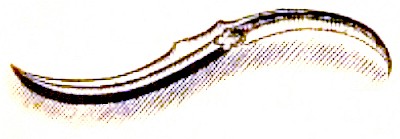
Folding Crooked Incision Knife, From The Chyrurgeons storehouse, By
Johannes Scultetus, p. 29 (1674)advises, "I use this most frequently for all incisions which is commonly made in every imposthume [abscess]; but principally in small incisions."7 Holme notes that it "is used to Launce wounds"8. However, he adds that it can be employed to "cut out dead flesh, and for many other uses besides"9. Scultetus adds, "With this also is the Pericranium parted from the skul, and the haw [a web or spot on the eye10] from the eie."11 Instructor Dionis does not seem to care for the curved scalpel, advising that "the crooked [knives] are never chosen but where the straight will not serve"12.
1 Pierre Dionis, A course of chirurgical operations: demonstrated in the royal garden at Paris. 2nd ed., 1733, p. 15; 2 Randle Holme, The academy of armory, 1688, Book III, p. 399; 3 Dionis, p. 15; 4 Johannes Scultetus, The Chyrurgeons storehouse, 1674, p. 28; 5 Holme, p. 399; 6,7 Scultetus, p. 28; 8,9 Holme, p. 399; 10 John Kersey, Dictionarium Anglo-Britannicum, 1708, not paginated, 11 Scultetus, p. 30; 12 Dionis, p. 15
6. Fleam
Included by: Charles Gabriel Le Clerc, James Cooke, Thomas Brugis & Randle Holme
Fleams are a rather curious instrument for this list in that they sometimes appear to be another name for lancets. However, four of the eight surgeons under study specifically advise including fleams in their portable kits. William Fabry specifies both a fleam and a lancet in the instruments for his pocket kit.1 Randle Holme likewise includes both in his list of instruments found in the plaster box.2 So at least these two authors indicated that they were separate instruments.

Dual-Ended Fleam From Pocket Kit (late 17th century)
Some of the confusion between fleams and lancets may arise from the variety of different ways a fleam could be fashioned. When describing a fleam, James Cooke says one end of the tool is used to peel the gum back from the tooth, while "the other end is a round sharp point"3.
Randle Holme describes several different types of fleams. His first one sounds like the one Cooke describes, "haveing a flat edge at the contrary end, to cleanse the teeth from Scales. And the other hath a sharp point to pick the teeth." He later notes that this is "the vulgar, or common way of makeing them". He goes on to say that "some have a sharp pointed hooke at one end, and flat at the other" while still others are "crooked at both ends, other[s have] one end crooked and hook like; and the other flat, yet ending in a sharp point, after the form of a leafe and are termed Gravers, or Flegmes with Gravers, which are for the same use as the flat end Flegmes."4 Gravers were not considered fleams by any surgical authors. See instrument 21 later in this article.
Fabry's list of instruments for the pocket kit gives the most enlightening
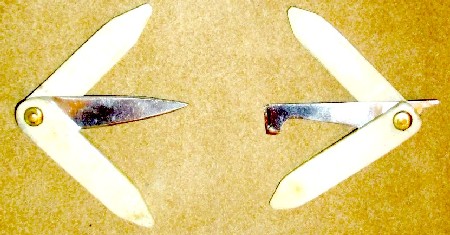
Photo: Mission - A Folding Lancet (left) vs. a Folding Dental Fleam (right)
explanation into the difference between how a fleam and a lancet would be used by the surgeon. He says that the pocket kit should include "Four Lancets to bleed withall" and "
A Flegme, to divide the Gums in the Tooth-ach."5 Fabry is clearly speaking of the flat style of fleam. Surgeon James Cooke says that "[i]ts proper use is to divide the gums from the teeth, either that they may bleed, or else that a tooth may be taken without danger of tearing the gums"6. Thomas Brugis explains this a bit differently, expanding upon the fleam's role in prizing the gum off the tooth. "It is an Instrument used to open Gums, and separate them from the tooth you intend to pull out, compassing the tooth with the round sharp end thereof close to the tooth, piercing deeper by little and little, until you feel it as low as the jaw-bone"7. Holme is even a little more graphic, stating that the "flat [part] at the other [end of the fleam], [is] for the scrapeing and cleansing of teeth from scales, and other hard substances which useth to fix themselves to the teeth."8
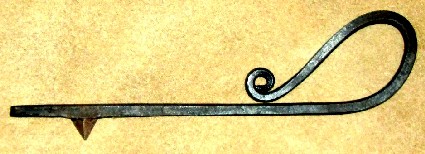
Photo: Mission -
Early Style Fleam Reproduction (c. 15th - 16th c.)
Cooke says that the other end of the fleam has "a round sharp point, which is to stop teeth withal."9 Cooke's meaning is not entirely clear, although he appears to be referring to plugging cavities using the fleam to jam something such as gold or silver into them to "stop" them up. Holme explains that when a fleam has a curved end "being made sharp doth serve not only for tooth drawing, but also to Launce [lance] and cut the Gums, to let them blood, or to cut oftentymes the superfluous flesh away, which over groweth the teeth."10
From this discussion, it may sound as if fleams were never used to let blood anywhere but in the gums. In fact, they were, although none of the authors who describe the fleam recommended it. Thomas Brugis says, "Some use to open a vein with this Instrument, but for mine own part, I do disallow it as very uncertain, and dangerous, for touching the Nerves or great Vessels."11
1 Guliielm. Fabritius Hildanus aka. William Fabry, Cista Militaris, Or, A Military Chest, Furnished Either for Sea or Land, 1676, p. 22; 2 Randle Holme, The academy of armory, Book III, 1688, p. 438; 4 James Cooke, Supplementum chirurgiae and the Military Chest, 1655, p. 419; 4 Holme, p. 438; 5 Fabry. p. 22; 6 Cooke,p. 419; 7 Thomas Brugis, Vade Mecum, 1689, p. 7; 8 Holme, p. 438; 9 Cooke, p. 419; 10 Holme, p. 438; 11 Brugis, p. 7
7. Forceps
Included by: Charles Gabriel Le Clerc, William Fabry, Peter Lowe, John Woodall, James Cooke, Thomas Brugis & Randle Holme
Seven of the eight authors under study mention forceps being included in their portable kits. They had a wide variety of uses, making them a sensible addition to any such kit.
Sea surgeon John Woodall started his description of forceps by saying they were "onely to be used" for eight different
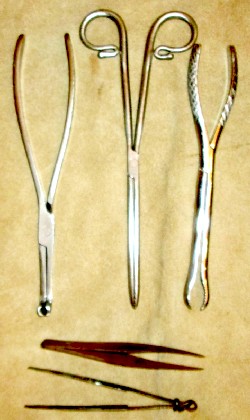
Photo: Mission
Some of the Author's Forceps - From top left:
Crow's Bill Forceps, Straight, Bullet Extraction,
Tweezers and Locking Tweezers
things and then ended the discussion by explaining, "it is an instrument of continuall use, and hath many offices in Chirurgerie."1 This may explain why so many of the surgeons who discuss the details of pocket kits and plaster boxes list them in the contents.
Forceps were grabbers that could be used in all sorts of enclosed spaces and they took various forms. Randle Holme says forceps "are made of different shapes according to the diversity of their uses"2. As a result some were large, some small, some straight, some curved, some with formal scissor-like handles and others that were what we would call tweezers. Holme mentions both 'crooked' (curved) forceps and tweezers as specific, individual surgical instruments in his book.
Such a common instrument would seem to have been made of iron or steel. Yet Lorenz Heister notes that forceps "are commonly made of Steel, but those of Silver are much neater."3 The idea of making forceps of silver may seem a bit extravagant, but it must be remembered that many pocket kits and plaster boxes made for long-practicing, esteemed surgeons contained silver instruments. Style cannot necessarily govern form, however. James Cooke says that "if they be of good steel they may draw out bullets that are but superficial, the silver are too weak [to retrieve bullets], they are to pull off plaisters, to draw forth things that may fall into the eares, &c."4
The many things that period surgeons suggested forceps could be used for included the removal of: "Emplasters, Pledgets, and Tents [from wounds]"5, "medicines from diseases"6, "a split [broken off piece of splinter] of a Bone"7, "a Bullet lying within reach"8 "and the fragments of them"9, "rags of woolen or linnen carried in with bullets"10, "Darts [referring either to small projectiles or insect stingers]"11, "a haire"12, "Splinters or Thorns"13, "ought [anything] that may by chance come into the eare, nostrills, the mouth, or throte, to the danger of the Patient"14, as well as "all other extraneous things of that kind, which are found in wounds: are by the toothed part of this Instrument taken forth."15. Forceps had functions other than simple extraction as well. Thomas Brugis advised that forceps could be used "to hold up any pieces of superfluous Flesh or Skin, thereby the better to cut it with the Scissers, or Incision Knife"16. Randle Holme said, "The broader end of this [the tweezers] will serve to spread Plasters on linnen cloth, or leather, for want of a Spatula."17

Crooked Forceps, From The academy of the armory, Randle Holme (1688) A couple of authors mention specific forceps that they felt should be included in portable instruments kits. Holme mentions the use of crooked forceps which he explains are "smal slender Pincers bended into a Semicircle with teeth, and a little Button at the points; the handles like a paire of Barbers Cissors."18 He says that these are "to pull forth, or thrust down, smal bones or any thing else, that chanceth to stick in the Throat."19 French surgeon Charles Gabriel Le Clerc also mentions a type of crooked forceps, although one that is clearly of a different design. These are used "to draw a Tooth" and are likely similar to those in use by many dentists today.20
1 John Woodall, the surgions mate, 1617, p. 26; 2 Randle Holme, The academy of armory, Book III, 1688, p. 425; 3 Lorenz Heister, A General System of Surgery in Three Parts, 1750, p. 12; 4 James Cooke, Supplementum chirurgiae and the Military Chest, 1655, p. 419; 5 Thomas Brugis, Vade Mecum, 1689, p. 6, See also Holme, p. 425, Woodall, p. 26 & Heister, p. 12; 6 Woodall, p. 26; 7 Brugis, p. 6, See also Holme, p. 425, Woodall, p. 26, Cooke p. 419, & Heister, p. 12; 8 Brugis, p. 6, See also Cooke, p. 419; 9 Holme, p. 425; 10 Cooke p. 419; 11 Holme, p. 425; 12 Woodall, p. 26, See also Cooke, p. 419 and Holme, p. 425; 13 Heister, p. 12, See also Woodall, p. 26; 14 Woodall, p. 26, See also Brugis, p. 6; 15 Brugis, p. 6; 16, 17 Holme, p. 425; 18 Holme, p. 434; 20 Charles Gabriel Le Clerc, The Compleat Surgeon, 1701, p. 6

